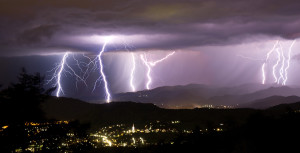 Lightning has been a mystery throughout the ages. In ancient times, the Greek god Zeus was thought to throw lightning bolts at misbehaving mortals or gods. The gods – Jupiter (Roman), Thor (Viking) and Chac (Mayan) also used lightning bolts as a symbol of power. In the Middle Ages, man thought that a church bell would protect the village from lightning strikes. They thought that the ringing of the bells would break up the lightning bolts. Many of the church bells where engraved with the Latin words “Fulgura Frango” translated “I break up lightning”. To this day there are many theories about what causes lightning strikes. We know it is caused by static electricity but how the clouds become statically charged is still a mystery. It is known that the thundercloud is polarized, meaning the positive charges are on the top of the cloud and the negative charge on the bottom. When this event occurs, the earth’s surface becomes positively charged (a
Lightning has been a mystery throughout the ages. In ancient times, the Greek god Zeus was thought to throw lightning bolts at misbehaving mortals or gods. The gods – Jupiter (Roman), Thor (Viking) and Chac (Mayan) also used lightning bolts as a symbol of power. In the Middle Ages, man thought that a church bell would protect the village from lightning strikes. They thought that the ringing of the bells would break up the lightning bolts. Many of the church bells where engraved with the Latin words “Fulgura Frango” translated “I break up lightning”. To this day there are many theories about what causes lightning strikes. We know it is caused by static electricity but how the clouds become statically charged is still a mystery. It is known that the thundercloud is polarized, meaning the positive charges are on the top of the cloud and the negative charge on the bottom. When this event occurs, the earth’s surface becomes positively charged (a  build-up of static electricity). As these electric fields build up, the air becomes more conductive. A ground discharge occurs between a cloud and the ground, but it does not start at the cloud and hit the ground. The air is so unstable that the cloud and ground both discharge at the same time and these charges meet in mid-air, creating a contact point, resulting in lightning. The contact point rapidly ascends upward at speeds as high as 50,000 miles-per-second! Although fascinating to watch, lightning is very dangerous, and even deadly. When caught in such a storm, the safest place to be is inside a sturdy building. Basic rules if you are caught outdoors is to avoid tall isolated trees and find a low-lying area away from fences and poles. Stay clear of small boats and do not go near the water! A vehicle is safe with the windows rolled up, but don’t touch any metal in the vehicle. If lightning does strike, the vehicle’s body will act as a lightning rod and conduct the charge into the ground. Contrary to what you have heard, the rubber of the wheels does not offer any protection. Most importantly, beware of a build-up of static electricity (hair standing on end), because that is a sure sign that lightning may be about to strike.
build-up of static electricity). As these electric fields build up, the air becomes more conductive. A ground discharge occurs between a cloud and the ground, but it does not start at the cloud and hit the ground. The air is so unstable that the cloud and ground both discharge at the same time and these charges meet in mid-air, creating a contact point, resulting in lightning. The contact point rapidly ascends upward at speeds as high as 50,000 miles-per-second! Although fascinating to watch, lightning is very dangerous, and even deadly. When caught in such a storm, the safest place to be is inside a sturdy building. Basic rules if you are caught outdoors is to avoid tall isolated trees and find a low-lying area away from fences and poles. Stay clear of small boats and do not go near the water! A vehicle is safe with the windows rolled up, but don’t touch any metal in the vehicle. If lightning does strike, the vehicle’s body will act as a lightning rod and conduct the charge into the ground. Contrary to what you have heard, the rubber of the wheels does not offer any protection. Most importantly, beware of a build-up of static electricity (hair standing on end), because that is a sure sign that lightning may be about to strike.
Previous ArticleRuns In The Family
Next Article The Driver’s View
SharLeigh
SharLeigh has an inquisitive nature – she is interested in current events, history, science and many more subjects, including things that go bump in the night! Since 1997, SharLeigh has scoured the internet, looking for interesting, fun and timely topics covering all sorts of human-interest subjects for her articles from her home in Fontana, CA.
